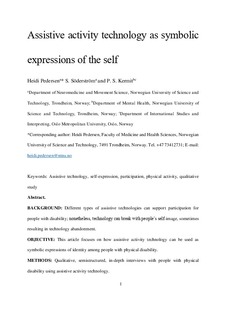| dc.contributor.author | Pedersen, Heidi | |
| dc.contributor.author | Søderstrøm, Sylvia | |
| dc.contributor.author | Kermit, Patrick Stefan | |
| dc.date.accessioned | 2020-03-13T09:17:53Z | |
| dc.date.available | 2020-03-13T09:17:53Z | |
| dc.date.created | 2019-10-09T17:34:39Z | |
| dc.date.issued | 2019 | |
| dc.identifier.citation | Technology and Disability. 2019, 31 (3), 129-140. | nb_NO |
| dc.identifier.issn | 1055-4181 | |
| dc.identifier.uri | http://hdl.handle.net/11250/2646665 | |
| dc.description.abstract | BACKGROUND: Different types of assistive technologies can support participation for people with disability; nonetheless, technology can break with peoples self-image, sometimes resulting in technology abandonment. OBJECTIVE: This article focuses on how assistive activity technology can be used as symbolic expressions of identity among people with physical disability. METHODS: Qualitative, semistructured, in-depth interviews with people with physical disability using assistive activity technology. RESULTS: The use of assistive activity technology is most often voluntary and based on personal interest. The use of assistive activity technology affects how the informants experience themselves and their social surroundings, and how they act in social activities. Assistive activity technology provides people with disability the opportunity to show themselves from a positive perspective in recognisable and commonly valued activities in society. This phenomenon is changing how other people see and understand people with disability. CONCLUSIONS: Assistive activity technology has the potential to contribute as symbolic expressions of identity for people with physical disability. The technology contributes through positively changing how individuals experience themselves and how other people perceive them. A new finding is that assistive activity technology differs from other assistive technology because the choice of using assistive activity technology is normally based on individual preferences and interests. | nb_NO |
| dc.language.iso | eng | nb_NO |
| dc.publisher | IOS Press | nb_NO |
| dc.title | Assistive activity technology as symbolic expressions of the self | nb_NO |
| dc.type | Journal article | nb_NO |
| dc.type | Peer reviewed | nb_NO |
| dc.description.version | acceptedVersion | nb_NO |
| dc.source.pagenumber | 129-140 | nb_NO |
| dc.source.volume | 31 | nb_NO |
| dc.source.journal | Technology and Disability | nb_NO |
| dc.source.issue | 3 | nb_NO |
| dc.identifier.doi | 10.3233/TAD-190236 | |
| dc.identifier.cristin | 1735673 | |
| dc.description.localcode | © 2019. This is the authors' accepted and refereed manuscript to the article. The final authenticated version is available online at: http://dx.doi.org/10.3233/TAD-190236 | nb_NO |
| cristin.unitcode | 194,65,30,0 | |
| cristin.unitcode | 194,65,35,0 | |
| cristin.unitname | Institutt for nevromedisin og bevegelsesvitenskap | |
| cristin.unitname | Institutt for psykisk helse | |
| cristin.ispublished | true | |
| cristin.fulltext | preprint | |
| cristin.qualitycode | 1 | |
